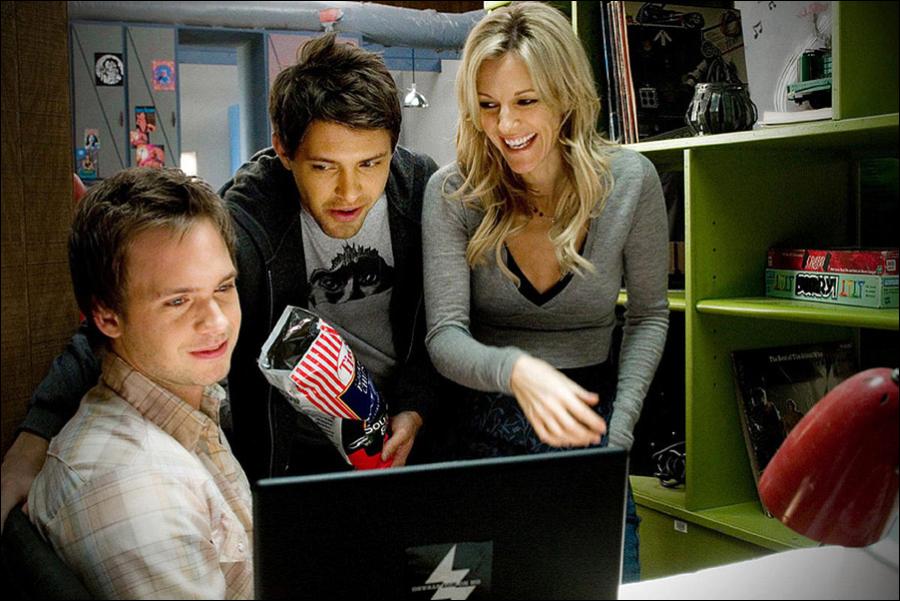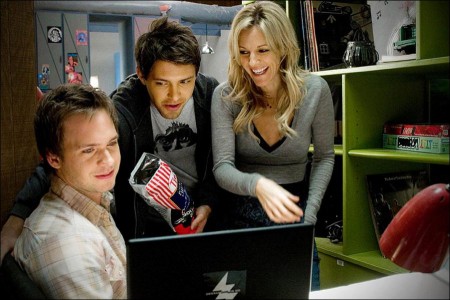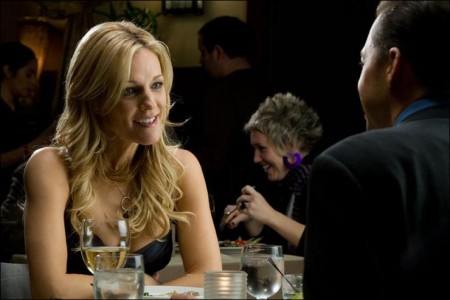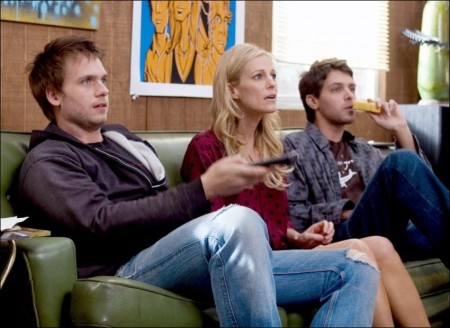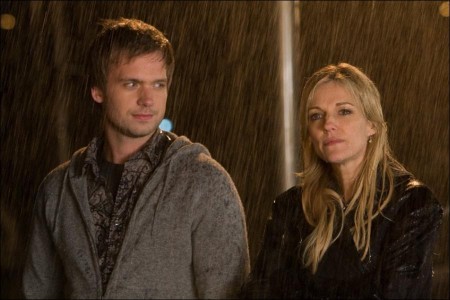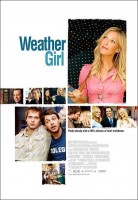The Inception
“I got the idea for Weather Girl after dating a woman about five years older than me,” explains Blayne Weaver, writer/director of Weather Girl. “The difference in age was minimal but the difference in where our heads were was huge. Not that she was ready to settle down, but the pressures she felt professionally, from her friends and from society kept hammering home this idea that ‘she didn’t have time’. I really liked the idea of this woman who seems to have it all (great job, ‘perfect’ boyfriend), but then gives it all up and has to start over again with those pressures looming over her.“
The Team
Tricia O’Kelley and Blayne Weaver first worked together on Weaver’s debut feature film, 2006’s Outside Sales. The film was a truly independent endeavor with a budget under $100,000. Weaver and his partner in Secret Identity Productions, Brandon Barrera, sold their house to finance the film.
O’Kelley played the romantic lead in Outside Sales and worked tirelessly for no pay because she loved the script. When she read the script for Weather Girl, she again connected to Weaver’s writing. “I was only a few pages into the script and already I knew that I had to play this role” she recalls. Over beers at an LA pub, they had the first real conversation about the realities of raising financing for the film.
“Honestly, I tried to talk her out of it” laughs Weaver. “I was still terribly in debt from Outside Sales, having sunk every penny I had (and didn’t have) into it. I warned her that the film would become her baby and she would want do ANYTHING to make it great… even go into a ridiculous amount of debt.”
O’Kelley ignored Weaver’s foretelling of doom and poverty, and they began pre-production with the intent of making another film for under $100,000. This delusion was dismissed as soon as they started working with Steakhaus Productions. Steak House was brought on to produce the film alongside Tricia. She had a great reputation in the indie film world and soon became an irreplaceable member of the team because of her knowledge of the terrain and ability to get things done. “We had an early meeting with a possible crew member and Steak asked the questions that we didn’t think to ask. It became clear that Steak just knew how to make movies” Says Weaver.
For cinematographer Weaver turned to frequent collaborator Brandon Trost. Trost and Weaver first worked together on Outside Sales. “Trost has DP’d over thirty movies and he knows how to get the best quality out of whatever equipment the production can afford” explains Weaver.
Weaver had never worked with production designer Michael Fitzgerald but they hit it off immediately. “In order to pull off the look and feel of a television studio, we had GET a television studio. So, we had this huge space and Michael suggested building the other main set piece on the soundstage. Well, that scared the hell out of me” remembers Weaver. Fitzgerald undertook construction (night and day) of a one bedroom, one bath apartment with a hallway and a room across the hall IN ADDITION to the set of ‘Good Morning Seattle’. These realities swelled the budget way beyond the tiny film Weaver and O’Kelley had initially conceived. That meant more investors… This meant that they needed NAMES.
The Cast
“When you’re working with a low budget and only able to offer actors a few hundred dollars a day, the first thing you need to do is legitimize the project” says Weaver. “Tricia had worked with the incredibly talented Jane Lynch before and they got along great. I love Jane’s work, Tricia loves Jane’s work, so we called her and ask her to do a small role. She really liked the script and agreed to do it for the bare minimum amount of money allowed under SAG rules. She was so enthusiastic from the beginning, and was really accommodating despite her incredibly busy schedule.”
After securing Jane Lynch, they turned to Andy Richter (who Tricia had also worked with) and offered him the role of Charles. He also really responded to the script and jumped on board. Once they had these two great actors attached, Weaver and O’Kelley turned to casting director Lauren Bass to guide the search for the other leads. Tricia, Lauren and Blayne began the huge search for “Byron”, “Walt” and “Sherry”, matching actors with Tricia and calling them back three (even four) times until they found the actors they were looking for in Patrick J. Adams, Ryan Devlin and Kaitlin Olson. (An interesting side note: Adams originally auditioned for the role of “Walt” and Devlin originally auditioned for the role of “Byron”. “We loved them both and knew we wanted to work with them, but something wasn’t quite right… until we switched things up and had them audition again, but for the opposite roles. Once we saw them in these roles, all the pieces came together and we knew we had the perfect guys for our movie,” explains Weaver.)
The character of Dale was a different process. The producers wanted a big name to help bring in the additional financing, and that meant making a straight offer. “I can’t say that I wasn’t nervous about it,” says Weaver. “When you make an offer to someone without ever having worked with them–without knowing how you’ll get along or if they even have a sense of humor– and then bring them onto a low budget set… I mean, that could really change the tone of a set and the film.”
The actor they all agreed upon was Mark Harmon. “Mark’s a great actor. I loved his dramatic turn on “West Wing”, his show “NCIS” is top-rated, and he’s really funny and charming in one of my old favorites, Summer School. We knew we didn’t have much of a chance of getting this highly-paid actor for the tiny amount we could pay but we took the shot. “
Mark responded to the script but wanted to sit down with Weaver to talk about the project. Weaver took Tricia along and they met Mark for coffee. He liked the script but because of scheduling with “NCIS” he didn’t think he could take on the larger role of Dale. But the filmmakers were floored when Mark offered to do a day player role. “That was it for me,” says Weaver. “Mark Harmon is willing to do a tiny part in this movie for free because he likes the script. THAT’S the kind of actor I want on my set. I wanted this guy for Dale.”
So began the ridiculously difficult process of getting clearance from Paramount for Harmon to play the role of Dale. The shoot fell during the writers’ strike, but Mark knew that as soon as the strike ended he would have to go right back to work. “We opened up the conversation with Paramount and gave them deadline after deadline for an answer,” recalls Weaver. “We couldn’t get an answer, but they’d keep telling us ‘It’s looking good.’ We were three days away from shooting and we knew that if Mark couldn’t do it we might not have time to find someone else.” It came to a head after the studio missed a ten o’clock deadline. “I finally called the agent at two o’clock. He was on his cell phone and just seemed like he didn’t have a care in the world. I could literally hear his expensive car with its expensive convertible top off and the wind blowing through his expensive hair.” “What can I do?” the agent said. “But it’s looking good.” To which Weaver responded, “Look, I know this isn’t going to make you a bunch of money, but Harmon wants to do it. Do you want to be the one who calls him and tells him he can’t?”
The Money
Finally they got their answer, and Harmon was locked in. So, now the main cast was assembled. With the addition of Mark Harmon they were able to turn to other stars for roles in the film. Blair Underwood, Enrico Colantoni, Alex Kapp Horner and Marin Hinkle joined up, all working for next to nothing. With a cast like that, the money would be no problem, right?
As cameras rolled on the first day, Weather Girl had only enough money to shoot 3 out of the 4 weeks of production…. they still didn’t have enough money to finish shooting, never mind post-production. Stress was high. Tears were shed. “It wasn’t that there was no money being offered,” explains Weaver. “The thing that made it especially difficult is that companies kept coming out of the woodwork and offering us 1/3 of the budget, but in exchange they wanted full rights. We had pulled the project together from scratch, had a multi-million dollar cast, and now these companies wanted to give us a fraction of what we had already raised but own the whole thing.”
They passed on offer after offer, and during breaks from shooting Tricia, Steak, Blayne and executive producer Brandon Barrera worked the phones. Finally, just a few days before the money ran out, an independent investor came through. “He was the first investor we approached yet the last one to commit,” says Weaver, “and he got us all the way through post.”
Losing Andy Richter
Five days away from shooting the role of Charles, we got a call from Andy Richter. He had just booked a huge movie and was going to New Zealand for THREE MONTHS. So, in addition to shooting a movie on a shoestring budget and taking every free moment to call and pitch to wary investors, we now had to track down an actor to play this part that would bring as much to the table as Andy Richter. Enter Jon Cryer.
We had been discussing Cryer because he and Harmon are friends, and had talked about the film. There was this whole thing where Tricia had done an episode of “Two and a Half Men” with Cryer and he and Harmon talked about how great she is or something. Anyway, we went after him with guns a-blazing. Lauren contacted his agent, Harmon put in a good word, Tricia gave him a call, and his publicist Karen Samfilippo got in on it, too. But the clincher was Marin Hinkle who plays Jon’s ex-wife on “Two and a Half Men”. She was already a part of our cast, and she talked to him about what a great project it was. We came at him from all sides and he never had a chance.
He read the script and agreed the next day. I wrote him an e-mail to welcome him aboard and to talk about how we’re going to shoot the scene. Jon’s such a great guy. He wrote back immediately and apologized for the hell I received as a child because of one of his famous lines from a little movie called Pretty in Pink. See, my name is Blayne and according to his character Ducky: “Blayne is not a name, it’s a major appliance.” You hear that a lot if your name is Blayne.
San Pedro Rain
Not many places in Los Angeles look like Seattle but you can come pretty damn close in San Pedro. We made the trip down with a skeleton crew to shoot some exteriors for a night. It should have gone smoothly… We had permits. We had this beautiful scene along the water on a public sidewalk. We did NOT, however, have permission to use the damn yacht club’s parking lot. Fortunately, we only needed to use their special little parking lot if we wanted to use lights or our rain effect….which was the whole point! So, we bought off the bastards (in their stupid captain hats) for two grand–which we could not afford–and shot through the night.
We had this really cool rain effect that was the last scene of the night. We throw a switch and the water truck drenches our little actors. We then get them out of the cold (it was about forty degrees and 4:00 am) and into their comfy trailer (which we couldn’t afford either). And that should be it. But the rain didn’t work. It worked as far as getting the actors soaked. Tricia’s hair, make-up, clothes: all drenched. Unfortunately, the rain started in a corner of the screen and slowly moved to the center like a half-assed lawn sprinkler, and THEN it kicked in. Shot ruined. We had to dry them off, re-do hair, re-do make-up. The effect worked the second time but EVERYONE was cranky, tired and cold. I will say, though… the B-roll footage of them standing in the rain while we were resetting for a long shot is some of the funniest I’ve ever seen. They were REALLY cold and this made them REALLY unhappy.
Seattle Rain
In my initial concept for the film, it rains during every single scene of the movie except one… and then before the end of the scene, it rains again. It was part of the melancholy tone I wanted for the film, in order to separate it from most other romantic comedies. We went to Seattle to shoot exteriors for a few days. It was February, part of the rainy season, and the weather report called for rain. And when the production team got to Seattle, it was pouring rain! But when the actors showed up the next day, it was the most beautiful day I had ever seen. Not a cloud in the sky, blinding sun, ridiculously cheery. And it stayed that way for the entire weekend. It irritated the hell out of me. But we went to great lengths in color-correcting to make it look less like the most amazing weather anyone has ever seen.
Storage Closets
We shot a great deal of the film on a sound stage that had been gutted and unused for awhile. As we were two days out from shooting and the art department was working feverishly to finish the set, Tricia insisted that we pull some painters and have them re-paint the dingy “storage-like” dressing rooms before the talent showed. It was the only fight we had during the entire shoot, and she won. I sent a couple of painters to do the dressing rooms–luckily, I think, because those dressing rooms WERE really gross and I would have been embarrassed eventually. But I’ll never forget the line she yelled: “I’m not putting Rico Colantoni in a storage closet!” Funny to me.
Production notes provided by Secret Identity Pictures.
Weather Girl
Starring: Tricia O’Kelley, Patrick J. Adams, Ryan Devlin, Kaitlin Olson, Mark Harmon, Jon Cryer, Jane Lynch, Blair Underwood
Directed by: Blayne Weaver
Screenplay by: Blayne Weaver
Release Date: July 10th, 2009
MPAA Rating: PG for language.
Studio: Secret Identity Productions
Box Office Totals
Domestic: $22,779 (100.0%)
Foreign: —
Total: $22,779 (Worldwide)
